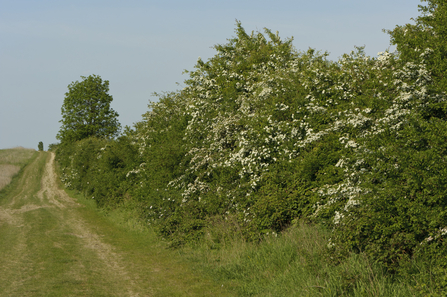
Hawthorn hedge by Chris Gomersall
Hedgerows are an extremely valuable habitat for wildlife as well as providing a natural barrier or boundary. Many species of bird depend on hedgerows and their margins for survival, particularly in areas with relatively few woodlands, such as Suffolk. Hedges, together with their associated habitats, such as ditches and banks, also provide a haven for many insects, wildflowers, small mammals, reptiles and amphibians.
As they often link habitats together, they provide natural ‘corridors’ along which wildlife can travel. By planting a new hedge in the correct place you can help to extend these vital links and increase their benefit to wildlife.
Choosing the species
The best hedges for wildlife are those with a good mix of different trees and shrubs. In the countryside these are often the oldest hedges. They were probably originally planted with hawthorn to provide a prickly barrier to sheep and cattle. Other types of tree or shrub have colonised over time.
Native trees and shrubs are best for wildlife, especially those which provide flowers and berries for insects and birds. Hawthorn, blackthorn and hazel are good for making a thick hedge, but field maple, holly, wild privet, dog rose and buckthorn can be planted too and will add variety to your hedge.
A typical mix of shrubs to create a traditional hedgerow is: 50% hawthorn, 25% blackthorn (but beware – this can spread into adjacent fields), 15% field maple, 2% holly, 2% wild privet, 2% guelder rose, 2% dog rose, 2% buckthorn.
Check your local hedges to see what grows naturally and then try to make sure your hedgerow reflects the local landscape.
Tall trees are a feature of many hedges. If you are planting a long hedge you can plant trees at 15—30m intervals. Oak, field maple and hornbeam are particularly good species to choose.
Size and numbers of plants
You should aim for creating a thick and bushy hedge as they are more beneficial to wildlife than a thin, straggly hedge. The best way to create a thick hedge is to plant a double row of trees and shrubs at a spacing of 20—30cm. This means about six plants for every metre of your hedge. If you measure the length of your hedge you should be able to work out how many plants you will need.
You may be tempted to buy large trees and shrubs to make an instant effect, but they will be more expensive and slow to grow. Instead, you should buy 60—90cm high ‘whips’ which have a better survival rate and will grow more quickly.
You may need to put up a post and wire fence on both sides of the hedgerow if it is in a very public place. This will help prevent damage. Rabbit and sheep damage can be reduced by using mesh fencing or tree guards.
Location, location, location
It is important that you consider your surroundings and ask if it is appropriate to plant a hedge, both in terms of its proximity to other habitats and its practicality. Make sure that you are not subdividing a small field that will create management issues.
Also, although hedgerows can be excellent habitat, do not assume that by planting up a site you are necessarily having a positive impact. Carry out a survey of the surroundings and make sure you are not losing other important habitat to create the hedgerow.
One of the attractions of hedges for habitat is that they can connect different sites, but remember corridors for wildlife are bit of a misnomer unless you think about functioning habitat.
Planting your hedgerow
The best way to plant a hedge is as follows:
1. Mark out two parallel lines with string, about 50cm apart, along the line of your new hedgerow.
2. Clear any grass and vegetation between the two lines of string.
3. Use 20—30cm lengths of cane to mark out the distances between the trees and shrubs, creating a zig-zag pattern.
4. Plant the shrubs in groups of about 5 of the same type. ‘Notch planting’ is usually the easiest method.
The best time to plant hedges is November—March. This is the period when the trees are dormant, between losing their leaves and producing buds, so you move them without harming them. You should avoid planting in very cold or windy weather to reduce the risk of damage to the roots before they become established. Never plant in soil that is frozen or waterlogged.
Looking after your hedgerow
The first year
During the summer you should weed around the base of the shrubs. This will prevent competition from grasses and other plants. However, a mulch of chopped bark placed along the length of the hedgerow will prevent weeds from growing up in the first place and help to reduce moisture loss.
You may find in late summer that some trees and shrubs have died. These gaps should be replaced with new shrubs in the autumn or winter.
In the first spring you should cut the shrubs down to 45—60cm above the ground. This hard pruning encourages the shrubs to bush out and will help to create a nice thick hedge.
Long-term care
Once your hedgerow has reached a good height, you can improve it further for wildlife by leaving a wide undisturbed margin adjacent to the hedge, ideally at least 2m wide. After several years, you can manage the hedgerow by trimming it into an ‘A’ shape.
This will encourage bushy, leafy growth around the base, providing cover for small mammals and nesting sites for birds.
Remember to remove rabbit guards once the hedge has established, usually after a couple of years.
For more information on looking after your hedge once it is established, have a look at our section on hedgerow management.
